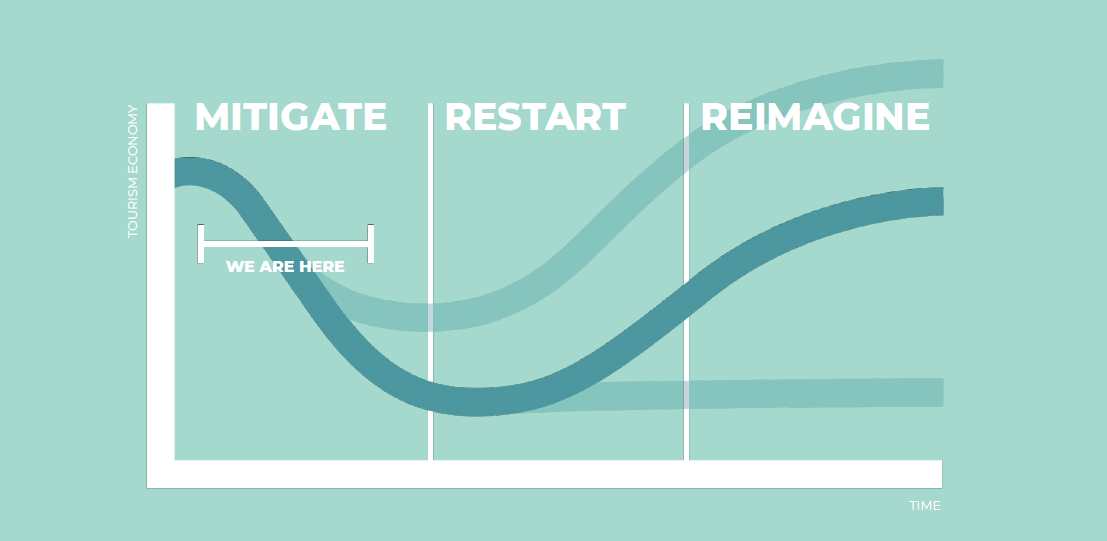Your organization’s path through the COVID-19 crisis will cross three stages: mitigating the impact, restarting local businesses and reimagining tourism.
No one can predict how the COVID-19 crisis will unfold. But you can anticipate elements of your response as a destination marketing organization (DMO). The Destination Think team has outlined three stages of recovery to guide our work: mitigating the impact, restarting local businesses and reimagining tourism. This model informs all of our work for DMO clients, whether we’re providing social media guidance, crafting a restart campaign, or revising a strategy.
This article is the first in a series of four that will examine why each stage is important to plan for and offer ideas for how you can lead your destination into the future. While the tourism industry faces enormous challenges and uncertainty, a clear plan will make the best course of action to see it through. As Chief Strategist William Bakker explained during Day 1 of our Virtual Forum, today’s DMOs must be willing to plan for a range of possible scenarios.
Consider these three stages in your scenario planning to make a positive contribution to your community and the businesses that rely on you, all the way through the crisis.
Stage 1: Mitigate the impact
In this moment of crisis, your local tourism industry doesn’t need a destination management organization. It needs a crisis management organization. The support you need to provide is vastly different from a business-as-usual environment, where advertising and promotion may have been the norm. Now, your industry needs you to become adept in strategic planning, financial aid, relief, communication, government relations and lobbying.
Community leadership is paramount. The first and foremost concern is for people’s health and safety, and to ensure they have their basic needs met. The “Langford Cares” initiative in British Columbia shows a strong example. That community is providing free hotel rooms to frontline healthcare workers who require isolation. Across Australia, similar programs are helping to protect homeless people from COVID-19 by providing temporary residence in vacant hotels. Actions like these will be remembered and savvy destination marketers will take cues from these examples to build lasting brand impact.
Stage 2: Restart your industry
During phase two, you can help your destination in numerous ways to aid an effective and safe restart. While this is exciting, you must fight the desire to revert to business-as-usual. Reopening a destination is a slow, gradual process. The path forward will depend, in part, on how your government chooses to lift restrictions, and on the capabilities of your tourism industry. Being able to anticipate changes to the course will help your DMO deal with a range of scenarios. Your organization will need to take on new roles to educate the public, for example, about when it is safe to travel.
At Virtual Forum, Chief Strategist William Bakker gave destination marketers a clear approach to strategic planning that is relevant for all phases. His four strategic takeaways include using relevant data to create scenario-based plans. This method allows you to quickly communicate what you’ve learned and also identify key assumptions, messages, and target audiences. Destinations that do this will be better able to adapt to changes in the restart process.
Stage 3: Reimagine tourism
The final stage presents an opportunity to rethink your approach to how the visitor economy can add maximum value to your community. Measures to curb the spread of COVID-19 have shown us what the world could look like, while the strain that global business places on the natural environment has never been more apparent. While this crisis is devastating, it is also teaching new lessons. If there is a silver lining, it is perhaps that DMOs have a unique opportunity to picture the future of tourism in a way that was not possible before. Early examples of change include reclaiming roads for recreation in New York City and a promise to “ditch party tourism” in the Austrian Alps. These are promising signs. As you imagine a new normal, you may find your DMO will need new capabilities. Consider whether you will invest in infrastructure; this will help your DMO prioritize expenditures. From there, look to incentivize digital transformation and develop human talent, which will help your destination keep up with the changing landscape.
This is the first of four articles in our series about the three phases of planning and action for DMOs during the pandemic. The next posts will explore each phase in more detail.
- 3 recovery phases for your destination and DMO: Mitigate, restart, reimagine
- Phase 1: Mitigate COVID-19’s impact on your destination
- Phase 2: Restart your destination’s tourism industry
- Phase 3: Reimagine what tourism and travel can become
Support for your DMO
From Bermuda to California to Campbell River, our team helps tourism destinations respond to crises and work toward recovery with poise and confidence. Speak to us to learn about our collaborative approach to strategy, communications, and creative solutions or click here to send us your RFP.










0 Comments